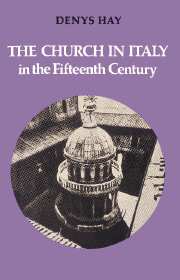Book contents
- Frontmatter
- Contents
- PREFACE
- 1 The problems of Italian church history
- 2 Diocesan and parochial organisation
- 3 The Schism in Italy: the emergence of an Italian papacy
- 4 The state of the clergy and laity in fifteenth-century Italy
- 5 The quality of Italian religious life. Reform
- 6 The Italian Renaissance and the clergy of Italy in the fifteenth century
- APPENDIX
- NOTES
- REFERENCES
- INDEX (NOT INCLUDING APPENDICES)
2 - Diocesan and parochial organisation
Published online by Cambridge University Press: 22 October 2009
- Frontmatter
- Contents
- PREFACE
- 1 The problems of Italian church history
- 2 Diocesan and parochial organisation
- 3 The Schism in Italy: the emergence of an Italian papacy
- 4 The state of the clergy and laity in fifteenth-century Italy
- 5 The quality of Italian religious life. Reform
- 6 The Italian Renaissance and the clergy of Italy in the fifteenth century
- APPENDIX
- NOTES
- REFERENCES
- INDEX (NOT INCLUDING APPENDICES)
Summary
Bishoprics
In the course of the previous discussion it was mentioned that Professor Alberigo had written to 100 diocesan archivists and had replies from half of them. This is noted again here not necessarily to justify his conclusion that, since half of the replies suggested that there were no significant pre-Reformation records, a biographical or any other approach based on the systematic use of local church records would be unfruitful – though this may well be true – but to lead the reader to the heart of the matter. Professor Alberigo might, had he so wished, have written to many more archivists. The vast number of bishoprics in Italy was and is one of the central facts about the Italian church.
How many bishoprics were there in fifteenth-century Italy? It is a much more difficult question to answer than one might suppose, since lists of bishops as printed for instance in Tangl's Kanzleiordnungen, let alone contemporary early printed vade mecums for the clerical visitor to Rome, contain errors and omissions, sometimes of an inexplicable kind. So – perhaps even more alarming in view of the use regularly made of it – does the Provinciale printed as an appendix to each volume of Eubel's Hierarchia catholica. Nor did the number remain invariable: a few bishoprics were created or recreated; a rather larger number were suppressed or united with other bishoprics.
- Type
- Chapter
- Information
- The Church in Italy in the Fifteenth CenturyThe Birkbeck Lectures 1971, pp. 9 - 25Publisher: Cambridge University PressPrint publication year: 1977



